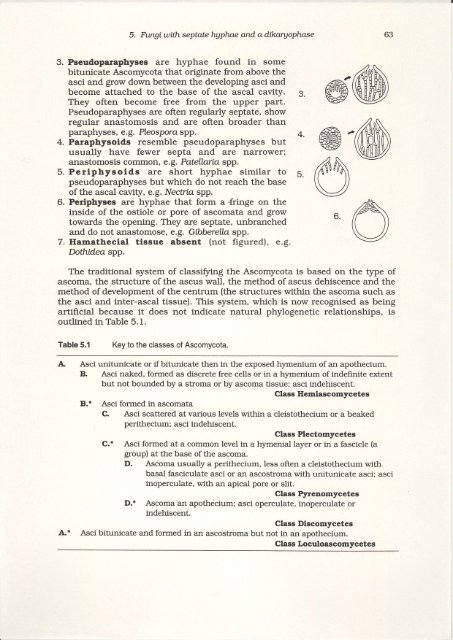Fungi with septate hyphae and a dikaryophase
Fungi with septate hyphae and a dikaryophase
Fungi with septate hyphae and a dikaryophase
Create successful ePaper yourself
Turn your PDF publications into a flip-book with our unique Google optimized e-Paper software.
5. F\ngt wtth septale haphae a nd a dtkargophase<br />
3. Pseudoparaphyses are <strong>hyphae</strong> found in some<br />
bitunicate Ascomycota that originate from above the<br />
asci <strong>and</strong> grow down between the developing asci <strong>and</strong><br />
become attached to the base of the ascal cavity.<br />
They often become free from the upper part.<br />
Pseudoparaphyses are often regularly <strong>septate</strong>, show<br />
regular anastomosis <strong>and</strong> are often broader than<br />
paraphyses, e.g. Pleospora spp.<br />
4. Paraphysoids resemble pseudoparaphyses but<br />
usually have fewer septa <strong>and</strong> are narrower;<br />
anastomosis common, e.g. Patellaria spp.<br />
5. Perlphysoids are short <strong>hyphae</strong> similar to<br />
pseudoparaphyses but which do not reach the base<br />
of the ascal cavity, e.g. Nectna spp.<br />
6. Periphyses are <strong>hyphae</strong> that form a -fringe on the<br />
inside of the ostiole or pore of ascomata <strong>and</strong> grow<br />
towards the opening. They are <strong>septate</strong>, unbranched<br />
<strong>and</strong> do not anastomose, e.g. Gibberella spp.<br />
7. Hamathecial tissue absent (not figured), e.g.<br />
Dothidea spp.<br />
63<br />
3. @@<br />
The traditional system of classi$ring the Ascomycota is based on the tytrle of<br />
ascoma, the structure of the ascus wall, the method of ascus dehiscence <strong>and</strong> the<br />
method of development of the centrum (the structures <strong>with</strong>in the ascoma such as<br />
the asci <strong>and</strong> inter-ascal tissue). This system, which is now recognised as being<br />
artificial because it does not indicate natural phylogenetic relationships, is<br />
outlined inTable 5.1.<br />
Table 5.1 Key to the classes of Ascomycota.<br />
A" Asci unitunicate or if bitunicate then in the exposed h5rmenium of an apothecium.<br />
B. Asci naked, formed as discrete free cells or in a hymenium of indefinite extent<br />
but not bounded bv a stroma or bv ascoma tissue: asci indehiscent.<br />
Class Hemiascomycetes<br />
B.* Asci formed in ascomata<br />
C. Asci scattered at various levels <strong>with</strong>in a cleistothecium or a beaked<br />
perittrecium; asci indehiscent.<br />
Class Plectomycetes<br />
C.* Asci formed at a common level in a hymenial layer or in a fascicle (a<br />
group) at the base of the ascoma.<br />
D. Ascoma usually a perithecium, less often a cleistothecium <strong>with</strong><br />
basal fasciculate asci or an ascostroma <strong>with</strong> unitunicate asci: asci<br />
inoperculate, <strong>with</strong> an apical pore or slit.<br />
Class P5zrenomycetes<br />
D.* Ascoma an apothecium; asci operculate, inoperculate or<br />
indehiscent.<br />
Class Discomycetes<br />
Ar' Asci bitunicate <strong>and</strong> formed in an ascostroma but not in an apothecium.<br />
Class Loculoascomycetes<br />
5.<br />
6.






![[Compatibility Mode].pdf](https://img.yumpu.com/27318716/1/190x135/compatibility-modepdf.jpg?quality=85)










